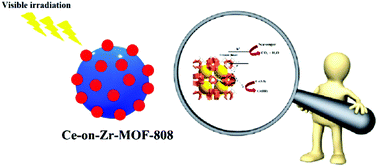Fabrication of a novel heteroepitaxial structure from an MOF-on-MOF architecture as a photocatalyst for highly efficient Cr(vi) reduction†
Abstract
Hexavalent chromium (Cr(VI)) is one of the toxic heavy metals. Due to its poisonous quality, carcinogenicity, and the danger it poses to human wellbeing and the security of oceanic living beings, it has been pulled in the last few years. As a consequence, the utilization of an efficient catalyst to remove this pollutant is an urgent task. In this work, Zr-MOF-808 and Ce-MOF-808 were combined to form a MOF-on-MOF hybrid named Ce-on-Zr-MOF-808, which was employed to reduce Cr(VI) to the less mobile Cr(III) species. Ce-on-Zr-MOF-808 was characterized by SEM, TEM, PXRD, FTIR, BET, TGA, UV-Vis and DRS analyses. Then, these isostructural MOFs were compared to illustrate the effect of the MOF bandgap on Cr(VI) photoreduction in chromium-contaminated water. Generally, among Zr-MOF-808, Ce-MOF-808, Ce-on-Zr-MOF-808 (1 : 1) and Ce-on-Zr-MOF-808 (1 : 2), Ce-on-Zr-MOF-808 (1 : 1), which had the lowest bandgap, exhibited the most efficient transfer of photo-excited electrons to the catalytic site and the best photocatalytic activity, thus achieving 100% reduction of Cr(VI) within 45 min under an air bubbling condition.



 Please wait while we load your content...
Please wait while we load your content...